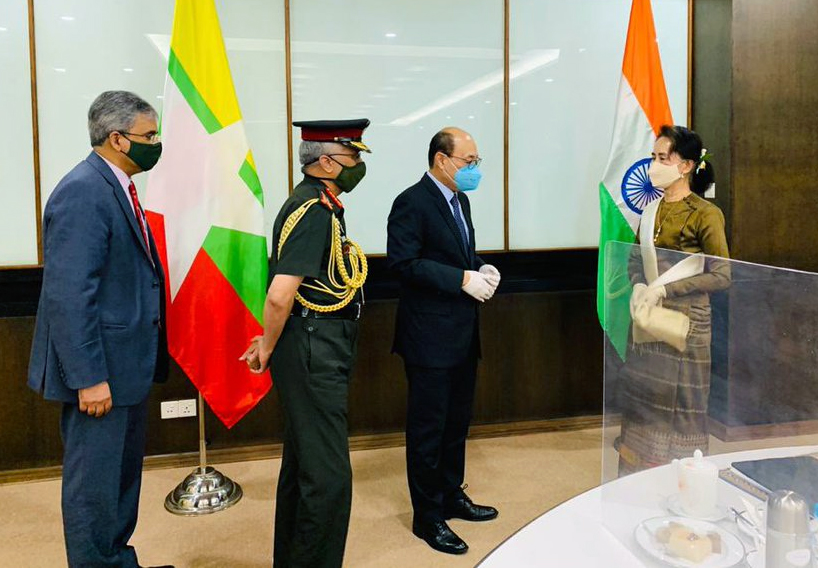Coordination between instruments of power also needs to be institutionalised rather than left to be sorted out by the force of personalities and leadership.
The Army Chief and Foreign Secretary visited Myanmar on a two-day official visit last weekend. It was an important visit. It signalled India’s emphasis on our neighbours, also our Act East policy, beginning right from the doorstep. We have been ceding ground to China over the last few decades, as far as our immediate neighbourhood is concerned. It is good that this is changing over the last few years. It is also significant for another reason
The Second World War showed the world that wars will have to be fought by the Army, Navy and Air Force together. The overall success of Normandy landings hides so many hiccups, glitches and things gone wrong in coordination and jointness, some with fatal consequences, as well. But the military had learnt its lessons well. After the war was over, all major militaries the world over made changes to the structures and processes to usher in jointness between the three services.
Diplomacy too played an equally important role, especially during the cold war which only got better with time. The jointness was a force multiplier. With the advent of hi-tech enablers, came network centric warfare and the boundaries blurred. Even the other instruments of power like economic sanctions, technical sanctions, energy security and so on were leveraged in concert with each other.
In the fields of cyber, space and other technological enablers, the boundaries between civil and military use as well as their employment also got blurred. As terrorism is increasingly becoming a deadly tool employed by non-state actors and even some states, the targets have also changed. What used to be collateral damage became prime targets—the civilian populated areas, because they are easier to target than military targets. In this backdrop, it is imperative that all forces, all instruments of power and all organs of the government work in unison to uphold national interest. Mere coordination between these organs is not enough; what is needed is joint planning right from the inception stage. Only then will we be able to exploit the full potential of each element. We need to graduate from coordination to joint planning, from jointness to integration, from force multipliers to synergy. India was a late starter in this aspect of jointness of the armed forces. It took us five wars and five decades to think about integrated structures. After the Kargil War, Headquarters Integrated Defence Staff (IDS) and some other tri-service structures were raised in 2001. But the punch was held back, the CDS was not appointed until now. Now he has been appointed and has been given a three-year mandate to implement the joint structures. These three years will be turbulent and some hard decisions will have to be taken, but this is something that has to be done.
On the other hand, coordination between instruments of power also needs to be institutionalised rather than left to be sorted out by the force of personalities and leadership. One effective step would be the articulation of a national security doctrine. Most countries have an apex level guidance document. In today’s world, there is a greater need to co-ordinate between the defence, diplomatic, financial, energy, cyber, space and several other domains to exert the country’s leverages. It will also help different ministries to draw their long-term and short-term objectives from this joint planning.
The Cabinet Committee on Security, which comprises the Defence Minister, Home Minister, Foreign Minister and Finance Minister under the chairmanship of the Prime Minister, is a good institution that coordinates at the apex level. There is, however, a need to have coordination at the functional level too—a function which can be performed by the Defence Planning Committee until a better mechanism is established. The need for a National Security Strategy or a guidance document however, remains paramount.
It will even help draw a balance between defence and diplomatic leverages to be exerted. Integration at all levels fetches good dividends—between Defence Ministry and Home Ministry for domestic issues of counterterrorism, law and order and disaster management etc and between Defence and External Affairs Ministries for external situations. For instance, the military talks between field commanders of India and China at Ladakh were attended by the MEA representative. Similar representation by the military in delegation level talks of foreign ministry will also add value, especially when the talks are about a border issue. Even otherwise, military diplomacy will always add value in dealing with countries where Army is in a pre-eminent position in the dispensation of its governance.
It is, therefore, important to modify our attitudes about turf concerns and put the nation first. If we continue to work and act in silos, we will learn to our peril. That is why Army Chief’s and a Foreign Secretary’s joint visit is a heartening sign, here’s hoping we have more of such jointness. India needs it.
Lt General Satish Dua is a former Corps Commander in Kashmir, who retired as Chief of Integrated Defence Staff. Views expressed are personal.

